
Bird Life In the Amazon Rainforest
Even if you’re not a birder, the colorful birds you find in the Amazon Rainforest are sure to delight and enchant you! Even though the rainforest is home to over 1,500 birds, we’ve come up with the 10 most captivating birds that you’ll want to ensure that you’ve seen on your trip to the rainforest because they are the birds that best represent the Amazon rainforest.
Scarlet Macaw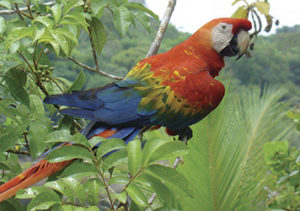
Scarlet macaw are one of the most distinctive rainforest birds with its bright red plumage covering the majority of its body along with yellow and blue feathers in the lower wings. It is also the largest parrot in the world, and the span of a scarlet macaw can reach almost 33 inches from beak to tail.
Found from southern Mexico to Peru, scarlet macaws are native to humid forests and prefer to spend their time near rivers, often in large (and loud!) groups. The majority of their diet consists of berries, leaves, nuts, and seeds, and they mate for life, laying two eggs per year. Mated scarlet macaws take care of one another by cleaning bugs from the feathers of each other and their offspring, sometimes for hours.
Plum Throated Cotinga
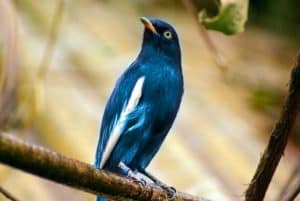
Found in Bolivia, Brazil, Colombia, Ecuador, and Peru, the plum throated cotinga is actually named more for the male than the female. While females are gray-brown with hints of blue,
plum throated cotinga males have the distinctive bright blue plumage and plum colored throat. Plum throated cotingas normally feed on fruit and insects and like natural habitats that are tropical or subtropical moist lowland forest, swamps, or even heavily degraded former forest.
Crimson Topaz Hummingbird
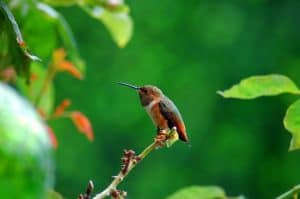 The largest hummingbird in Brazil and second in size only to the giant hummingbird, the crimson topaz hummingbird is often found in the canopy of lowland rainforests along rivers and creeks in Amazonian Brazil, southern Brazil, and the Guianas. While the crimson topaz hummingbird has a colorful plumage, the male’s most striking and distinctive features are its two tail feathers than extend longer than the rest, are curved, and are crossed half-way down.
The largest hummingbird in Brazil and second in size only to the giant hummingbird, the crimson topaz hummingbird is often found in the canopy of lowland rainforests along rivers and creeks in Amazonian Brazil, southern Brazil, and the Guianas. While the crimson topaz hummingbird has a colorful plumage, the male’s most striking and distinctive features are its two tail feathers than extend longer than the rest, are curved, and are crossed half-way down.
King Vulture
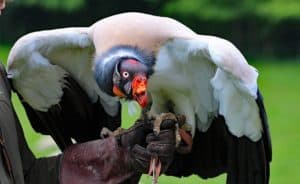
While not the most attractive rainforest bird, the king vulture is the largest New World vulture, except for condors. Unlike many other New World vultures, the king vulture does not have eyelashes. Additionally, both males and females sport a fleshy wattle known as a “caruncle” that bulges from their beaks, but the purpose is unknown to scientists. Finally, although ugly, the king vulture is extremely distinctive with a neck of orange, green, yellow, and purple-blue feathers, the majority of its body covered in white feathers, a black band that runs along the rear edge of the wings.
Golden-Headed Manakin
Although there are around 60 species of manakins located in the American tropics, the golden-headed manakin is particularly distinctive (and cute!). They typically weigh less than half an ounce and measure just slightly over 3.5 inches. They are known for their sliding mating ritual, their jumping, and their call. The males can be immediately recognized, thanks to their completely black body, except their yellow bill, golden head, pink legs, and white and red thighs.
Harpy Eagle
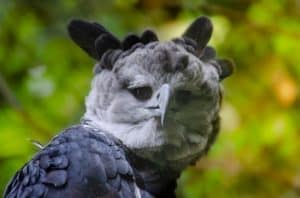
Although few individuals have seen a harpy eagle in the wild, they are a sight to behold. The Largest raptor in the Amazon rainforest and one of the largest eagles in the world, the harpy eagle was named after the harpies of Greek mythology—known for being scary creatures with hooked beaks and claws that flew—by early South American explorers.
Harpy eagles mostly feed on mammals, including sloths and monkeys, but will also go after macaws and toucans. They are known are having legs that are almost as thick as the wrist of a small child and back talons that are larger than the 5-inch claws of a grizzly bear.
Gray-Winged Trumpeters
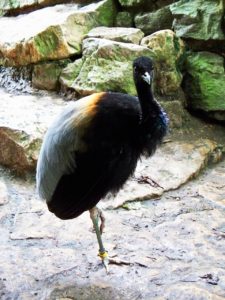
Although you can find these in the Amazon rainforest, you’ll often see people keeping gray-winged trumpeters as pets because they hunt snakes and have a loud alarm call. While they normally eat fruit, they will also eat arthropods and small vertebrates like snakes. Covered in mostly black feathers, the neck has purple, green, and bronze plumage.
What is distinctive about gray-winged trumpeters is that they are polyandrous, so females are allowed to mate with more than one male. Like many birds, they have elaborate and loud courtship dances, but the gray-winged trumpeter will take it to a new level and sometimes even somersault. You’ll rarely see a trumpeter flying, but sometimes they will run quickly if needed!
Hoatzin
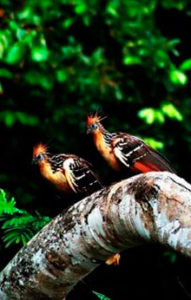 Probably the strangest bird on this list, the hoatzin has a lot of different names—reptile bird, skunk bird, stinkbird, or Canje pheasant. It is distinctive for many reasons, including its nasty smell, its cluminess, and its loud behavior. In addition, the hoatzin is also known for the claws on two of the wing digits of chicks. But its most unique characteristic is its digestive system that is similar to that of a cow, enabling the hoatzin to eat leaves and buds only. No other bird has this digestion method.
Probably the strangest bird on this list, the hoatzin has a lot of different names—reptile bird, skunk bird, stinkbird, or Canje pheasant. It is distinctive for many reasons, including its nasty smell, its cluminess, and its loud behavior. In addition, the hoatzin is also known for the claws on two of the wing digits of chicks. But its most unique characteristic is its digestive system that is similar to that of a cow, enabling the hoatzin to eat leaves and buds only. No other bird has this digestion method.
Green Oropendola
Found in forests in the Amazon basin, the green oropendola is a common sight, and it is known for its pale bill with a distinctive orange tip. The majority of the feathers on the green oropendola—as the name implies—are green with pale olive green head, breast, and back and grayish-green wings. Green oropendolas are polygamous birds that have multiple mates, are sociable and like to be around other birds, and build distinctive long bag-shaped nests.
Toucan
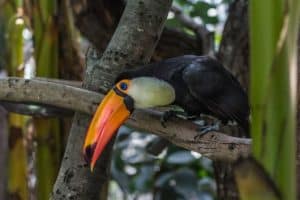
Last but not least is the icon of the rainforest, the toucan. The name comes from the sound that the bird makes, which often sounds like croaking frogs. Although females have a higher voice than males, both have an extensive variety of sounds from barking and croaking to growling and tapping.
Even though toucans are often compared to hornbills, they are close relatives to woodpeckers. Except the toucan’s bill can be up to four times the size of its head and almost as long as the rest of its body!
While a trip to the Amazon rainforest wouldn’t be complete without seeing many of these birds, you certainly couldn’t leave without seeing this extremely unique, playful, and most well-known tropical bird!